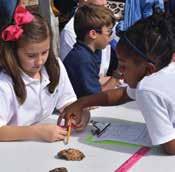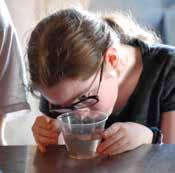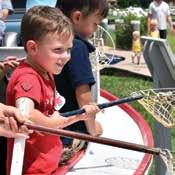CHESAPEAKE LOG
A PUBLICATION OF THE CHESAPEAKE BAY MARITIME MUSEUM



Kristen L. Greenaway, President, 4955
Kathi Ferguson, Executive Assistant, 4955
Tracey Johns, Vice President of Communications, 4960
Izzy Mercado, Communications & Art Director, 4943
Bethany Ziegler, Content Creator & Strategist, 4995
Liz LaCorte, Director of Development, 4956
Carly Faison, Development Coordinator, 4950
Nancy Wells, Membership Coordinator, 4991
Bill Gilmore, Vice President of Facilities Management, 4949
John Ford, Facilities Manager, 4970
Sam Fairbank, Facilities Management, 4969
Joseph Redman, Facilities Maintenance, 4969
Chloe Tong, Facilities Maintenance, 4969
M. Branden Meredith, Vice President of Finance, 4958
Howard Parks, Controller, 4957
Trish See, Staff Accountant & Human Resources Manager, 4985
Joe-Ann Hanna, Staff Accountant & GSS Manager, 4954
Steven Byrnes, Vice President of Operations, 4959
Sara McCafferty, Museum Store & Admissions Manager, 4963
Michael Gorman, Boatyard Manager, 4968
Jennifer Kuhn, Boatyard Program Manager, 4980
Joe Connor, Shipwright, 4968
James DelAguila, Shipwright, 4967
Joshua Richardson, Marine Mechanic, 4967
Michael Allen, RPM Foundation Shipwright Apprentice, 4967
Spencer Sherwood, Seip Family Foundation Shipwright Apprentice, 4967
Todd Taylor, Charity Boat Donation Program Director, 4990
Joshua Mills, Charity Boat Donation Program Associate, 4997
Karen Walpole, Charity Boat Donation Program Administrative Assistant, 4997
Shannon Mitchell, Director of Events, 4953
Liz Cowee, Wedding & Events Coordinator, 4944
(Exhibitions, Curatorial, Education and Volunteer)
Pete Lesher, Chief Curator, 4971
Richard Scofield, Assistant Curator of Watercraft, 4966
Jenifer Dolde, Collections Manager, 4996
Lee Olson, Exhibitions Specialist, 4973
Jill Ferris, Director of Education, 4986
Allison Speight, Volunteer & Education Programs Manager, 4941
Matt Engel, Lead Educator, 4974
James P. Harris Chair
Diane J. Staley Vice Chair
Richard J. Johnson Treasurer
Richard W. Snowdon Secretary
Schuyler Benson
Pat Bilbrough
David C. Blitzer
William C. Boicourt
Simon F. Cooper
William S. Dudley
Duane H. Ekedahl
Len N. Foxwell
Howard S. Freedlander
Leeds Hackett
Robert N. Hockaday, Jr.
Francis Hopkinson, Jr.
Deborah Lawrence
Kathleen Linehan
Frank C. Marshall
Donald L. Martin
Patrice Miller
Elizabeth C. Moose
Talli Oxnam
Bruce A. Ragsdale
David W. Reager Charles A. Robertson
D. Bruce Rogers
Lelde Schmitz
John L. Seidel
Richard C. Tilghman, Jr. Enos T. Throop, V Susan E. Wheeler
Carolyn H. Williams
Kristen L. Greenaway President
Richard T. Allen
CG Appleby
Alan R. Griffith
Margaret D. Keller
Richard H. Kimberly
Charles L. Lea, Jr. D. Ted Lewers, MD
Fred C. Meendsen
John C. North II
Sumner Parker
Robert A. Perkins
Joseph E. Peters
Norman H. Plummer John J. Roberts
Tom D. Seip Henry H. Spire
Henry H. Stansbury Benjamin C. Tilghman, Jr. Joan Darby West
Martha Austin
Kathy Bosin
Mike Cottingham
Jaime Fontanazza
Frank Garahan
Robbie Gill
Lauren Greer
Jay Hudson
Sherri Marsh Johns
Pat Jones
Bill Lane
Trish Payne
Matthew Peters
Heather Pickens
Estela Vianey Ramirez
Spence Stovall
Jay Tawes
Cassandra Vanhooser
Jaime Windon
Brenda Wooden
To reach staff members directly, dial 410-745-xxxx.
Use each staff member’s four-digit extension to complete the call. To email, use staff member’s first initial and full last name @cbmm.org
The Chesapeake Bay Maritime Museum is dedicated to preserving and exploring the history, environment, and people of the Chesapeake Bay.
RELEVANCE. We provide meaningful and accessible experiences to everyone who cares about our Mission—all of our communities and constituencies.
AUTHENTICITY. We seek genuinely to represent the people and cultures whose stories we preserve and tell.
STEWARDSHIP. We value the priceless assets entrusted to us and accept their preservation and enhancement as our paramount responsibility—our collections, our campus and facilities, our financial resources, and the volunteers and staff who perform our Mission and make CBMM the rich enterprise it is.
Sign up to receive Navy Point News, featuring announcements and news about our programs, festivals, exhibitions, and more. Email havefun@cbmm.org to be added to our mailing list, or sign up online at cbmm.org
Editors: Izzy Mercado, Bethany Ziegler
Creative Director: Izzy Mercado
Copy Editors: Tracey Johns, Jodie Littleton
Contributing Writers: Dick Cooper, Kristen Greenaway, Pete Lesher, Kate Livie, Bethany Ziegler
Production: Pixel, Print & Post
The Chesapeake Log is a publication of the Chesapeake Bay Maritime Museum. ©2018 CBMM. All rights reserved.
213 North Talbot Street St. Michaels, MD 21663 410-745-2916 | cbmm.org
HOURS: May to October, 9am–5pm November to April, 10am–4pm
CONNECT WITH US:
by Kristen L. Greenaway
CBMM makes campus upgrades; Annual Festivals and Special Events; Upcoming Exhibitions

Volunteer Profile: Audrey Brown by Bethany Ziegler
The Prize for a Most Innovative Canoe by Pete Lesher
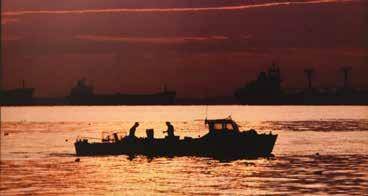

Edna
’VE RECENTLY RETURNED from this year’s biennial conference for ICMM, the International Council of Maritime Museums. This 18th ICMM conference was hosted by the National Maritime Museum of Chile, in Valparaiso. What a stunning city!
I was honored to have been appointed Programme Committee Chair two years ago. And, at this year’s conference, I was equally honored to be elected for an eight-year term to ICMM’s executive council. The academic program took a full year to organize and brought together 43 speakers from 22 countries, all presenting maritime museum-related content over five days. I had the opportunity to present on the complementary relationship between traditional boatbuilding methods and technology, to help achieve maritime museum ship or small craft restoration goals, using the restoration of our historic 1889 bugeye Edna Lockwood as an example.
Our theme this year was Discoveries! ‘Discovery’ has rich and suggestive meanings; it can mean to survey, to explore and examine, to display, to expose, to view, to be the first to find or observe something, to understand how something works. The word was particularly apt for Valparaiso—one of the most beautiful and important ports on the Pacific coast of South America—and the starting point for many historical voyages of exploration and discovery.
The trip brought its own personal discoveries for me. Exploring historic Valparaiso was fascinating. But at the end of the conference, I had an unplanned opportunity to fly to Rapa Nui— Easter Island—for a couple of days. Many of you may feel the same hope I did as a child—perhaps one day to personally see the moai that mark the heritage of the world’s most isolated inhabited island. The experience was everything I could have imagined, and brought a great discovery to me about a sense of authentic place.
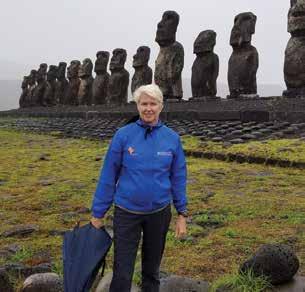
Creating the thrill of discovery, and points of access—another key theme that arose from the conference—is fundamentally inherent in everything we are working to achieve at CBMM. Via our education programming for all, our floating fleet, our working Boatyard, and our exhibitions & collections, we strive to give you the opportunity to explore and examine, to find or observe something you may not have noticed before, to understand how something related to the heritage of the Bay works that you may not have encountered or understood before.
In short, to discover! At the Chesapeake Bay Maritime Museum. Your place to discover!
Creating the thrill of discovery is fundamentally inherent in everything we are working to achieve at CBMM.
NGOING UPGRADES to the Chesapeake Bay Maritime Museum’s campus, and plans for its future growth, continue with CBMM completing a number of improvement projects and taking major steps in its Master Plan process.

This fiscal year, we have installed a campus-wide alert system, made improvements to many of our exhibition buildings, completed re-pointing Dodson House’s brickwork, landscaped the new Patriot Park Garden, purchased new software systems for our administrative and collections staff, and moved the replica John Smith shallop to sit outside our administrative offices as a free public exhibition.
Generous community, state, and individual support has also allowed us to expand our Rising Tide AfterSchool Boatbuilding program, whose participants launched a boat of their own creation during this
year’s Community Day celebration. Upcoming priorities include expansion of our shipwright apprentice program, the completion of various additional deferred maintenance projects, and a push to double the number of K–12 students visiting campus over the next five years.
In 2015, we launched a comprehensive campaign to support museum improvements and grow our endowment, with a goal of securing the future of CBMM, and thus the history and culture of the Chesapeake Bay. The campaign aims to solve challenges in dealing with older facilities while creating new opportunities to engage with our more than 80,000 yearly guests.
“It's been almost 15 years since CBMM last held a campaign,” said CBMM President Kristen Greenaway. “In that time, a great deal has changed in the life of CBMM’s infrastructure, as well as expectations of the 21st-century museum guest.”
Our Master Plan process is an integral part of this five-year comprehensive campaign to allow the development of long-term campus enhancements, including the locations of four proposed new buildings.
To complete the proposed Master Plan process, we hired Ann Beha Architects, a firm based in Boston, Mass., that works to balance contemporary architectural
Support Us: The Chesapeake Bay Maritime Museum is dedicated to preserving and exploring the history, environment, and people of the Chesapeake Bay. Gifts to The Annual Fund enable CBMM to educate and inspire the next generation of Chesapeake Bay stewards.

To support this mission, visit cbmm.org/donate.
It's been almost 15 years since CBMM last held a campaign. In that time, a great deal has changed in the life of CBMM’s infrastructure, as well as expectations of the 21st century museum guest.
Kristen L. Greenaway, Presidentexpression with the revitalization of historic resources. Currently, we're in the planning and consulting phase, with the architectural firm to present their concepts soon.
“We can’t wait to see what they come up with,” Greenaway said. “We’re ecstatic about what the future holds for CBMM.”

Community Day, and Maritime Model Expo (Day 2) (Free admission for everyone)

Free admission for everyone.
Reduced admission for CBMM members and their guests.
Please remember to keep pets at home during festivals. Leashed pets are welcome at CBMM on non-festival days.
Rain Date: Sunday,






Carry-on alcohol is strictly prohibited at all events where alcohol is available for purchase.
Tickets are available at the door on the day of the event. Advance festival tickets can be purchased online at cbmm.org.
Credit cards will be accepted at the door for admission. Festival-goers are encouraged to bring cash for use inside the gates. In 2018, CBMM will offer an on-site ATM.
Guests are encouraged to take photos and video of their visit to CBMM.
NOTE: CBMM photographs festivals and attendees for promotional use. Permission to use is implied by your visit to CBMM.

For more information, visit cbmm.org

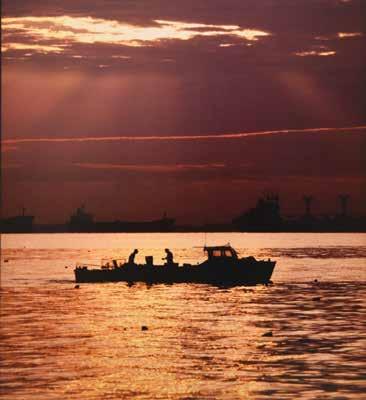
Through June 3
Van Lennep Auditorium
Bob Grieser (1946–2017) was a photojournalist who worked for the Indianapolis Star, Washington Star, Los Angeles Times, and Chesapeake Bay Magazine He covered yacht racing events and sailing in waters around the globe, including the America’s Cup, Louis Vuitton Cup, and Heineken Regatta. In 1990, Grieser published Chesapeake Bay, an art book featuring his black-and-white photography. Capturing the Spirit of the Chesapeake Bay, drawn in part from the photographs in his book, toured museums from St. Michaels to San Diego in the following years. In 2004, the Chesapeake Bay Maritime Museum commissioned Grieser to photograph scenes from around the region for its exhibition At Play on the Bay. This exhibition features 15 photographs selected from Grieser’s earlier exhibition, Capturing the Spirit.
Through April 1
Waterfowling Building
Potomac Waterfowling: Gunning the Nation’s River follows the harvesting history from 18th century statesmen like George Washington—who wrote about memorable hunts of the Potomac’s stunning numbers of waterfowl—to the 20th century, when the combination of Washington, DC’s growing economy and the rich Potomac environment spurred both commercial and sport markets for waterfowl.
Through April 8
Steamboat Building
Robert de Gast’s photographs of the late 1960s and ’70s documented the Chesapeake’s oystering industry, shorelines, and lighthouses at a watershed moment, both for the Bay and for photography. Deftly incorporating modern abstract elements into images that conveyed grit, humor, and atmosphere, de Gast masterfully represented the last days of the Chesapeake’s maritime golden age. Robert de Gast’s Chesapeake features masterpieces selected from more than 10,000 images in CBMM’s de Gast collection.
April 14 to March 2019
Waterfowling Building
Cradled by the Chester River and the Chesapeake Bay, Kent County’s rich environment has fostered a long tradition of waterfowl guiding, gunning clubs, and decoy carving. Carvers like John Glenn, the Uries, and Charlie Joiner, created unique rigs that were commissioned and gunned over on secluded Kent County coves teeming with waterfowl. Since the late 1800s, the superior shooting of the county’s waterfront estates attracted well-heeled sportsmen to exclusive gunning clubs, where skilled local guides provided a great day’s take. Through objects, images, and selected decoys, Guides, Gunning Clubs, and Carving Co-Ops explores Kent County’s enduring waterfowling culture—one that continues to flourish in the fields, necks, and islands of the deeply rural region.
OR THE PAST DECADE, guests visiting the Chesapeake Bay Maritime Museum on a Saturday have been able to turn to a reliable face for a warm welcome, and knowledgeable answers to their questions.
That face belongs to Audrey Brown, 93, who serves as a greeter—and occasional tour guide— on one of CBMM’s busiest days of the week.

“Being a greeter on Saturdays is very entertaining because so many people come,” Audrey says. “Many people come who don’t even know what they can find here. So we can steer them to that.”
Audrey moved to the Eastern Shore from South Carolina in 2004 so she could be closer to her daughter (who lives in Connecticut), “but not where it was cold and snowing and hilly.” Audrey’s brother already lived in the area, and it was his influence that first introduced her to Talbot County.
That brother is also responsible for introducing Audrey to CBMM. He brought her for a visit before her move during a Mid-Atlantic Small Craft Festival—something he knew she would appreciate since both grew up racing small boats in Barnegat Bay, New Jersey.
“I like the boats, the waterfront—that’s what brought me here in the first place,” Audrey says.
After her move, Audrey became a member, and soon learned that a friend of hers was volunteering with CBMM’s Crab Cakes program, after seeing her pictured in a CBMM publication. Her friend let Audrey come along to help out with a round of the program, and then encouraged her to take docent training if she was interested in doing more.
Audrey was, and that same year became a docent, and led Crab Cakes for a while before finding her calling as a greeter—a position she took up simply after hearing there was a need for it, but one that seems to have stuck.
“It’s fun for the most part,” Audrey says. “People seem to be appreciative of having a few words from a greeter before they start off exploring campus.”
BETHANY ZIEGLERLeft: Noddy’s builder and owner, Oliver Duke, was awarded this replica trophy for winning the Governor’s Cup race in 1937.
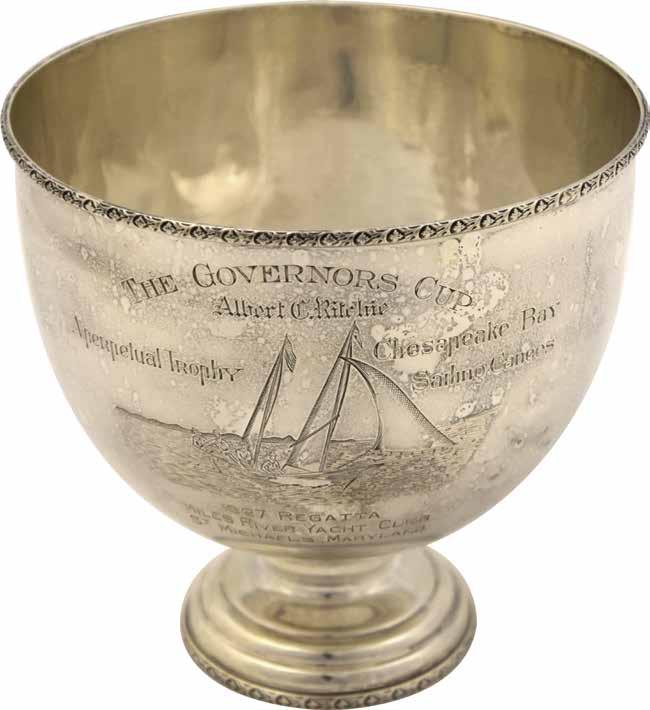
ecently, CBMM received an interesting trophy for the collections: a footed silver bowl engraved with the image of a log canoe under sail, and “The Governor’s Cup – Albert C. Ritchie – A Perpetual Trophy – Chesapeake Bay Sailing Canoes – 1927 Regatta – Miles River Yacht Club – St. Michaels Maryland.” The engraving on the back side includes a conflicting date: “Won by Noddy – Oliver Duke – 1937.”
The bowl resembles a scaled-down version of the Governor’s Cup, a perpetual trophy at the Miles River Yacht Club, and the most coveted award among racing log canoes. In 1937, the winner was indeed a canoe named Noddy.
Noddy, named for a type of sea bird, first competed among the racing log canoes in 1933. Inspired by the creation of the Governor’s Cup in 1927, she was the third newly constructed canoe. Tilghman Island boatbuilder John B. Harrison had completed much larger canoes, Jay Dee and Flying Cloud, for the 1931 and 1932 seasons. Noddy was the product of a brilliant Talbot County builder, J. Oliver Duke, of Royal Oak (1869–1948). Duke, the nephew of Oxford shipbuilder William P. Benson, had built a bugeye and four skipjacks on the shore of Oak Creek in the 1890s. He left his native Talbot County to pursue a career with Sun Shipbuilding & Dry Dock Company in Chester, Penn., but retained property in Royal Oak.
Compared to earlier canoes, Noddy had an unusual hull shape. She was quite full in the ends; some describe her as “cigar shaped.” She was among the smaller racing log canoes, with a length on deck of less than 28 feet, but proportionally a bit wider in the beam than older canoes. Her rig was likewise innovative; both foremast and mainmast curved dramatically back near the head so that the tops of her foresail and mainsail also curved—much like the head of a modern windsurfer sail. The “spreets” serving in lieu of
Left: Noddy trails the old log canoe Mary Rider in the Miles River Regatta of 1934. Photographer unknown, collection of the Chesapeake Bay Maritime Museum, gift of Nancy Van Arkle.
a boom were not straight, but curved, and ran down both sides of the sail—once again, like the boom on a modern windsurfer. The straight spreets that were then typical on log canoe rigs would interfere with the shape of the sail on one tack or the other, but this problem was solved with Duke’s creative new rig.
Duke went on to build at least six more canoes— Cecelia Mae (renamed Edmee S.), Ginny Babe, Kittiwake, Patricia, and at least two canoes that were unfinished when he died in 1947. One of those two final canoes was completed soon thereafter, was named Oliver’s Gift, and is still sailing today.
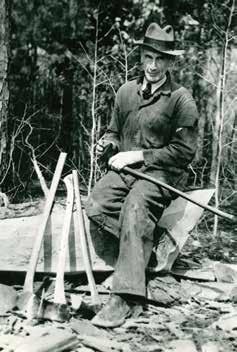
Noddy continued to compete in log canoe races among a succession of owners—Duke Adams, Jim Burrows, James B. Harrison, Robert L. Murray, James Stevenson, and Bradford Johnson, her current owner. During a very breezy August 1951 Miles River Regatta, Noddy simultaneously carried away both masts; they broke at the point where her famous curved spreets were attached to the mast with a throughbolt, a design flaw that caused a weak point. The masts were replaced with conventional straight spars. Noddy returned to competition and captured the Governor’s Cup again in 1958. She continues to compete in the log canoe fleet today.
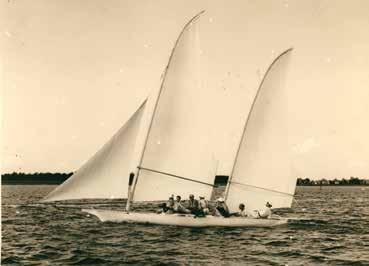
The sterling silver trophy is a gift of Nancy Van Arkle, a descendant of Duke.
Left: Oliver Duke, builder of Noddy and other log canoes, sharpens his tools while working on Oliver’s Gift, about 1938. Photographer unknown, collection of the Chesapeake Bay Maritime Museum, gift of Nancy Van Arkle.
IME AND TIMING have been Edna E. Lockwood’s fiercest enemy, and dearest friend. The old bugeye was built with an enduring log bottom and handsome lines by a shipwright who was at the top of his game, but she was launched just as the great Chesapeake Bay oyster bonanza of the mid-1880s was crashing. Her hand-hewn nine-log hull—a meld of stone- and iron-age technologies—kept her afloat long after more “modern” plank-on-frame skipjacks rotted away. Her plodding reliability made her useful and functioning long after contemporary vessels were abandoned or replaced. Her good looks and pedigree helped her last long enough to become historically significant, and too valuable to let die.
 by DICK
by DICK
Since she was launched from the shores of Tilghman Island on October 5, 1889, Edna’s lifeline has paralleled an unrivaled sweep of American history. World wars and depressions have come and gone. Travel by air went from fantasy to routine. Horses, the primary mode of human transportation for millennia, were replaced by cars and trucks within a few decades of her launch. Computers revolutionized every aspect of modern life. In 1889, about one in every 700,000 Americans had a telephone; now, more than 90 percent of adults have cellphones in their pockets. And, in true Eastern Shore fashion, Edna
Built in 1889, bugeye Edna E. Lockwood serves as the constant in a story that spans the 127 years between the horse and buggy, and space exploration.
COOPER
never strayed far from home. She is undergoing a major restoration at the Chesapeake Bay Maritime Museum, less than 20 miles down the road from where she was built.
Edna is, after all, a sailing time machine that connects the romantic allure of the old Chesapeake with the digital age. Classic black-and-white photos of the sailing oyster fleet in its prime hang on the walls of homes, restaurants, offices, and public spaces around the Bay. They are
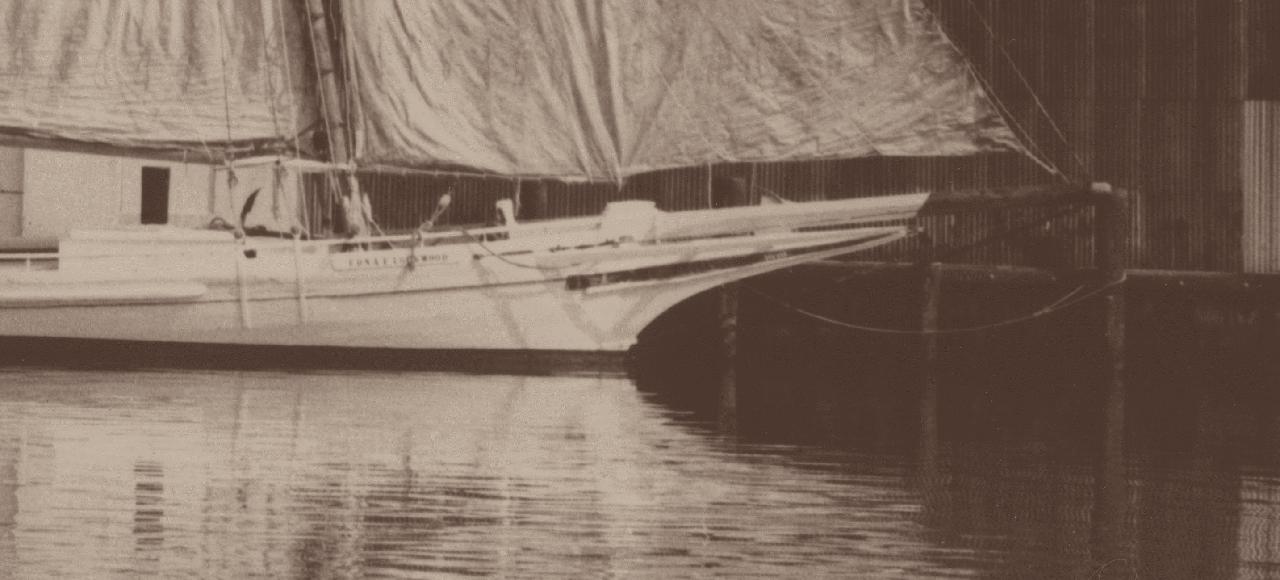
frequently augmented with new, color images of weatherbeaten watermen in white boots manhandling loaded dredges full of oysters onto the decks of skipjacks. For as much as the rest of the world has changed, the way Marylanders pull oysters from the Bay has remained pretty much the same.
Books have been written about the changes that have taken place over the past 125 years, but a quick
Above: The Chesapeake-Potomac hurricane of 1933 devastated the Mid-Atlantic, and was ultimately responsible for cutting the Ocean City inlet. It also devastated the shipyard of John B. Harrison, builder of Edna Lockwood. Collection of the Chesapeake Bay Maritime Museum.

Left: After the Civil War, the Chesapeake Bay became a major commercial corridor, with steamboats connecting the Eastern Shore to the rest of Maryland and Virginia. This drawing by Alfred R. Waud of the steamship Louisiana underway was created between 1860 and 1865. Collection of the Library of Congress.
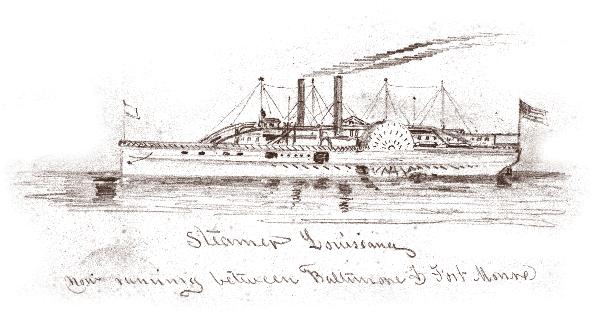
Above: Daniel Haddaway, pictured, commissioned John B. Harrison to build Edna Lockwood, and owned the nine-log bugeye until 1892. Collection of the Chesapeake Bay Maritime Museum, gift of Lucretia Krantz.
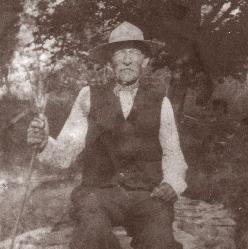
Top: Charles Lindbergh is pictured with his airplane, "Spirit of St. Louis." By the time Lindbergh flew nonstop across the Atlantic to Paris in 1927, almost all of the technological advances to oystering under sail on the Chesapeake had been made. Harris & Ewing, 1927. Collection of the Library of Congress.

look at some highlights can provide a sampling of the magnitude of transformative occurrences since Daniel W. Haddaway commissioned John B. Harrison to build him a new oyster boat.
The 1880s were a tumultuous time in America. The wounds of the Civil War were still raw, and the nation’s economy was in and out of recession. During the war, the Chesapeake Bay was a Union highway, moving troops and munitions from the North to the battlefields of Virginia and farther south. Twenty-five years later, the Bay was a major commercial corridor in a nation that was growing exponentially as immigrants streamed in from around the world. Steamboats, running on daily time schedules, connected the communities of Maryland’s Eastern Shore with the western shore and tidewater Virginia. A spider web of railroads hauled seafood, produce, goods, and passengers north and south, linking the Shore to the rest of the world. The population of the U.S. went from 38.5 million after the Civil War, to 62 million by 1890, and 75 million a decade later. Millions of bushels of oysters were being harvested every year, and new, sanitary canning procedures were making the Chesapeake oyster a staple as far away as the gold fields of the Rockies. Captain Daniel Haddaway joined Maryland’s Oyster Police Force, and sold Edna in 1892 to a partnership of James Roe and Richard Richardson. Three years later, John Tall bought her. New York, Chicago, and Philadelphia all had more than a million residents; Baltimore ranked seventh with 435,000. The minor-league Orioles won their first professional National League pennant over the New York Giants in 1894. In 1901, the Automobile Club of Maryland was formed; the following year, Maryland’s legislature required all children to go to school.
Within a few years of buying Edna, Tall replaced her hand-cranked dredge winder with one powered by a gasoline engine installed on deck. He replaced the tiller with a steering wheel and built a patent stern to give the helmsman more room, and to make it easier to launch and haul the newly powered yawl boat.
About the time he was making those modifications, the Wright Brothers and Glenn Curtiss were perfecting their new flying machines, and 70 blocks of downtown Baltimore burned to the ground. The oyster harvest on the Bay dropped precipitously. In Annapolis, a nervous Maryland Legislature established the Shell Fish Commission, ordered the first major survey of Chesapeake Bay’s bottom, and began encouraging embryonic forms of aquaculture.
At 21 years old, Edna Lockwood was nearing the end of her life expectancy. Tall sold her to William Warfield in 1910, and a few years later, J. Hilleary Wingate became part owner, and sailed her for the next four decades.
In 1914, a young Baltimorean named Babe Ruth was signed to pitch for the minor-league Orioles, but was quickly traded away to the Boston Red Sox. That year, the Panama Canal opened to shipping traffic, an event that greatly increased the ocean-going ship traffic on the Chesapeake. The United States entered World War I in 1917, and scores of young Eastern Shoremen were shipped overseas to fight. For most of them, it was their first time away from home. One of the Doughboys, a young Dorchester County waterman named Orville Parks, was seriously injured during a German chemical attack in France. While he was recovering, Parks dreamed his mother, Rosie, who had died while he was a boy, came to him and told him he would survive. He did, and returned to oystering the Bay. In 1955, he named his new skipjack Rosie Parks in her memory.
On November 2, 1920, radio station KDKA in Pittsburgh was the first U.S. radio station to broadcast live, when it reported the election of Warren G. Harding as president. Throughout the ’20s, Edna Lockwood sailed the Bay, oystering from September through March, and carrying goods and produce to market in the off-season. By the time Charles Lindbergh captured the world’s attention when he flew non-stop across the Atlantic to Paris in 1927, almost all of the technological advances to oystering under sail on the Chesapeake had been made. In 1929, the Wall Street crash threw the nation into the Great Depression. As if on cue, the Chesapeake oyster yield also continued to fall, dropping under two million bushels landed for the first time.
The Depression hit the Eastern Shore hard, with most
residents struggling to get by. It was also a time of racial strife. Jim Crow laws enacted in Maryland in the early 1900s had institutionalized the segregation that had existed throughout the state since the end of slavery.
Edna’s builder, John B. Harrison, was an entrepreneur who had expanded his business operations to include a shucking and packing house and a cannery, as well as his boatbuilding business on a man-made oyster-shell island jutting into the Choptank River. Besides workboats, Harrison built yachts and racing log canoes, including Jay Dee, one of the biggest and fastest in the fleet, using logbuilding skills he had fine-tuned over the decades since Edna was launched.
The great Chesapeake-Potomac hurricane of 1933 slammed into the region in August of that year, devastating waterfront towns and cities, causing extensive flooding, and cutting the Ocean City inlet to the ocean. Tilghman Island was inundated during the storm, forcing residents to take refuge on their rooftops. Harrison’s businesses were all but washed away.
As the 1930s progressed, it seemed as if the world, and especially Maryland, craved distraction from the hardships of the Depression, and the public romance between King Edward VIII of England and American socialite Wallis Simpson, a native of Maryland, gave them plenty of juicy gossip to savor. The Baltimore Sun referred to the divorced Simpson as the “Baltimore Belle,” and when the king decided to marry his love and forsake his throne, banner headlines usually reserved for the outbreak of wars and natural disasters screamed “KING EDWARD ABDICATES.” On the calmer waters of the Chesapeake, the oyster population gradually began to rebound. More boats joined the dredge fleet, but all were plank-onframe skipjacks. Edna’s log-bottomed contemporaries, once numbering in the hundreds, were vanishing rapidly, though she kept hard at work.
Throughout World War II, oyster harvesting continued in a greatly diminished form, as one in every six Americans was in uniform, or directly involved in some phase of the war effort. In 1944, Harrison built his last boat, a motorboat for his son, Ben. He died on October 25, 1945 on Tilghman Island at the age of 79. He was eulogized as “a quiet and retiring man, dependable in every manner.”
When the GIs returned home to the Eastern Shore, the pace of oystering picked up. The national economy had been resuscitated by the war and was booming. The Maryland Legislature passed a major roads bill that included funds to build the first Chesapeake Bay Bridge. The opening of the bridge in 1952 was a game changer for Eastern Shore life. Two years later, the St.
Above: Governor Theodore McKeldin leads a procession across the Chesapeake Bay Bridge on its dedication day in 1952, with the ferry John M. Dennis in the background. The opening of the bridge was a huge deal for the Eastern Shore of Maryland, previously accessible mostly by rail or steamboat. Collection of the Chesapeake Bay Maritime Museum.
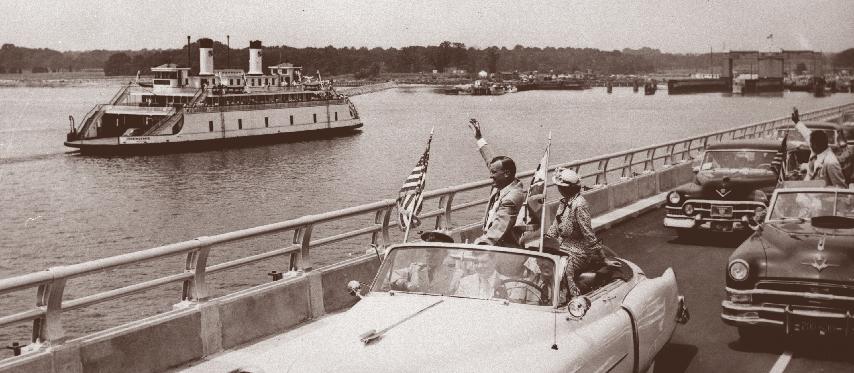
Louis Browns crossed the Mississippi River and were transformed into the modern Baltimore Orioles. That was the year that the Dow Jones Industrial Average passed the 382 mark, a level last seen on the eve of the Wall Street Crash of 1929. Televisions were quickly appearing in living rooms on both sides of the Bay. Telephones, which 10 years earlier were owned by businesses and the wealthy, were now standard equipment in every home. The Western TV show “Bonanza” went on air in 1959 as the first all-color series. Americans began to feel as if happy days were here again.
In 1955, 66-year-old Edna was still strong enough to go “drudging,” and was sold by Nettie Wingate to Captain William Jones. Jones continued to work the water with her for the next 11 years. It was during that period that the oyster harvest went into a steep decline, with the number of bushels landed dropping year after year. About the time the Beatles appeared on “The Ed Sullivan Show” in 1964, the remaining oystermen could barely pull a living wage out of the icy winter waters of the Chesapeake. Jones sold Edna in 1966, a move that
proved to be very important in the long term. The old bugeye had served well for far longer than expected. Thanks to Harrison’s skills and the durability of her pine log hull, she was still afloat. The new owner was John R. Kimberly, CEO of the Kimberly-Clark Corporation, who had a home near Easton. Kimberly recognized Edna’s beauty and historic significance, hidden under a patchwork of repairs and flaking white paint, and set about restoring her. He hired renowned Cambridge shipbuilder Captain Jim Richardson to do major repairs. Kimberly sailed Edna as a private yacht for the next several years, frequently docking her as a showpiece at the newly formed Chesapeake Bay Maritime Museum, in St. Michaels. Kimberly, who was a strong and early CBMM supporter, officially donated the bugeye to CBMM in 1973. In 1976, CBMM shipwrights rebuilt her topsides and deck, and in 1994 she was designated as a National Historic Landmark, the last of the original fleet of log-hulled Chesapeake bugeyes.
Edna is now midway through her second major restoration, as the CBMM Boatshop crew fashions a new log hull while preserving the original bottom as a permanent exhibit of Harrison’s skill. It makes perfect sense, in an Eastern Shore sort of way, that a few years after Harrison cut down the big pines from the Tilghman forest, and dragged them to his boatyard to carve out Edna’s first hull, a dozen loblolly seeds took root on the lower Shore. They were overlooked by loggers for almost 125 years. They grew tall, straight, and clear—quietly waiting for the time when Edna needed them.
Over the past 50 years, the Chesapeake Bay Maritime Museum has created a lasting legacy: we are the world’s leading institution dedicated to exploring and preserving the history, environment, and people of the Chesapeake Bay, through authentic, hands-on experiences.
Making a planned gift is a wonderful way to show your support and appreciation for CBMM and its mission while accommodating your own personal, financial, estate planning, and philanthropic goals. With smart planning, you may actually increase the size of your estate and/ or reduce the tax burden on your heirs. Just as importantly, you will know that you have made a meaningful contribution to CBMM.
Please contact us for assistance or to discuss your personal situation and objectives.
Liz LaCorte
Director of Development
410-745-4956
llacorte@cbmm.org | cbmm.giftplans.org
[My favorite thing about CBMM is] the ability to bring kids [to CBMM] and let them really experience things.
Beth Loker, CBMM board member, 2013–2015
On May 21, 2017, friends and family of Beth Loker gathered at CBMM’s Community Day to honor and remember Beth, who passed away in 2015 at age 67.

Beth’s legacy of supporting the Chesapeake Bay Maritime Museum through her volunteer service, along with her ultimate gift of a bequest to CBMM’s endowment, continues to inspire others.
Beth, we thank you.
Beth's LEGACY will continue to impact children well into the FUTURE.
Your planned gift to CBMM fortifies our foundation, and builds your Chesapeake legacy.
In 1982, author Lila Line broke ground with her book Waterwomen, a piece sharing the stories of women working in the maritime industry. In 2017, we look back at her photographs, now a part of the Chesapeake Bay Maritime Museum’s collection, and reflect on the role of women on the Bay.
story by KATE LIVIE photographs by LILA LINE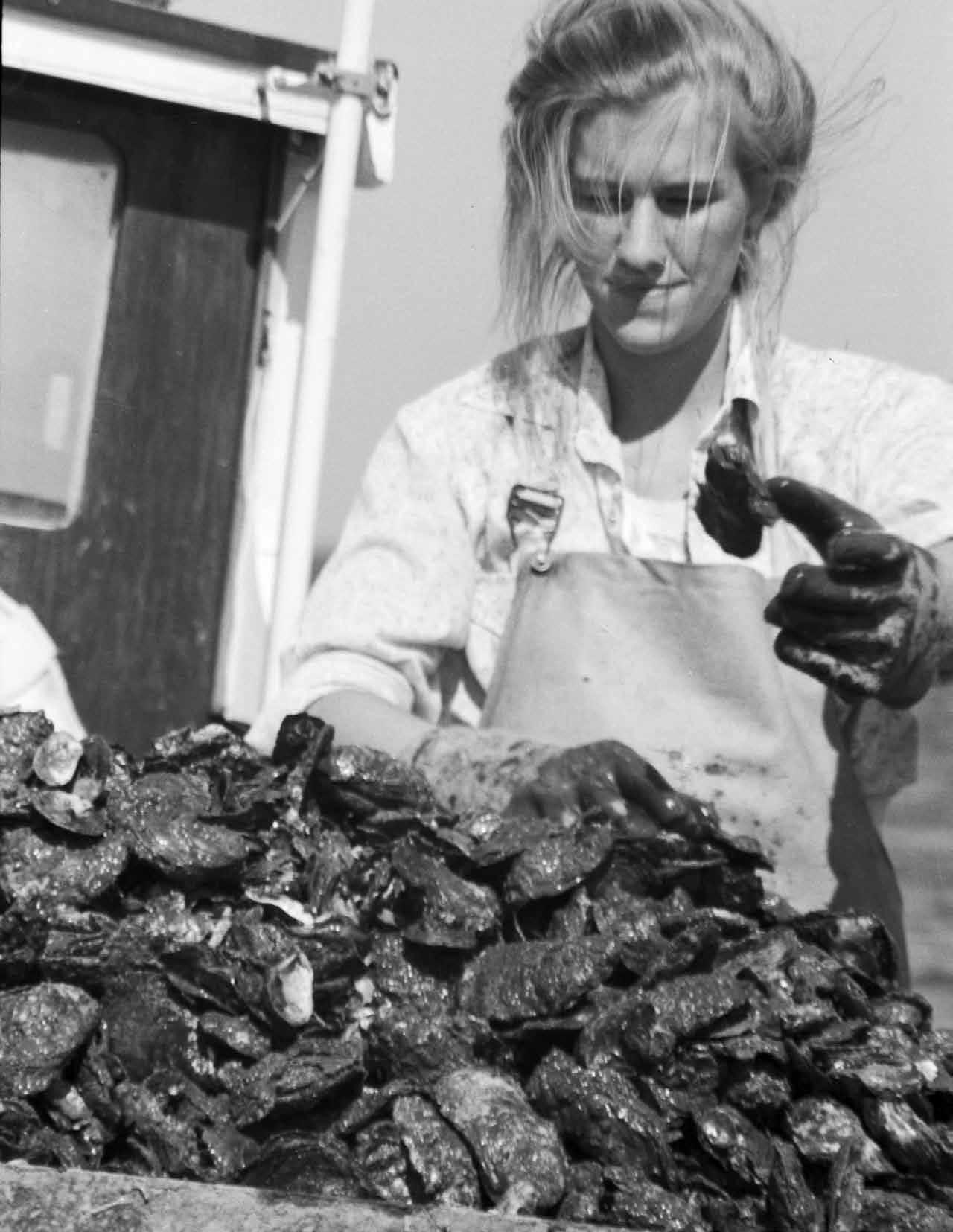
N THE COLLECTIONS of the Chesapeake Bay Maritime Museum is a remarkable body of work. Black-andwhite photographs capture women at different maritime tasks—zipping up a thick wetsuit to prepare for oyster diving, hauling fish from a poundnet, baiting a trotline. Today, in our post-feminist world, these images might seem banal, but in the early 1980s they represented the revolutionary truth that women could be, and were, watermen.
These photographs, the work of author Lila Line, were ultimately published along with interviews of her subjects in the 1982 book Waterwomen. It was the first time that the role of women in traditional Chesapeake fisheries was not just documented—it was celebrated. Line, a native of Brooklyn, NY, had moved to the Eastern Shore in her fifties. A product of the women’s rights movement, she had raised a family before she attended college and fulfilled her lifelong dream of becoming a writer. Waterwomen was deeply informed by Line’s unique perspective as an outsider, and her value for the often-unnoticed work of women.
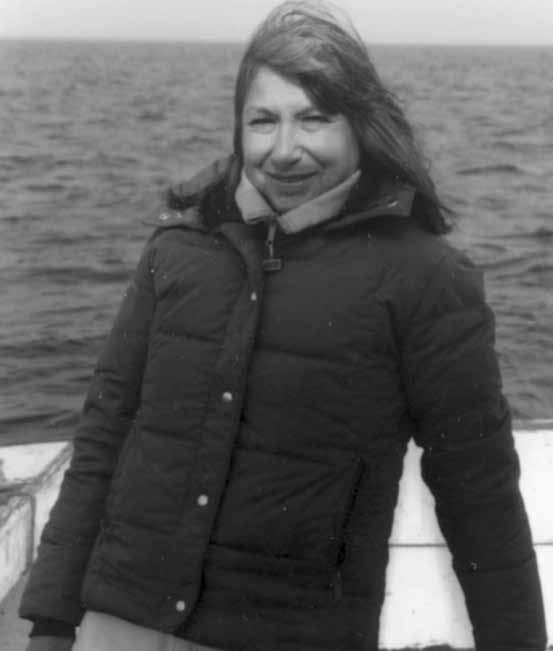
In Waterwomen, Line documents both women doing,
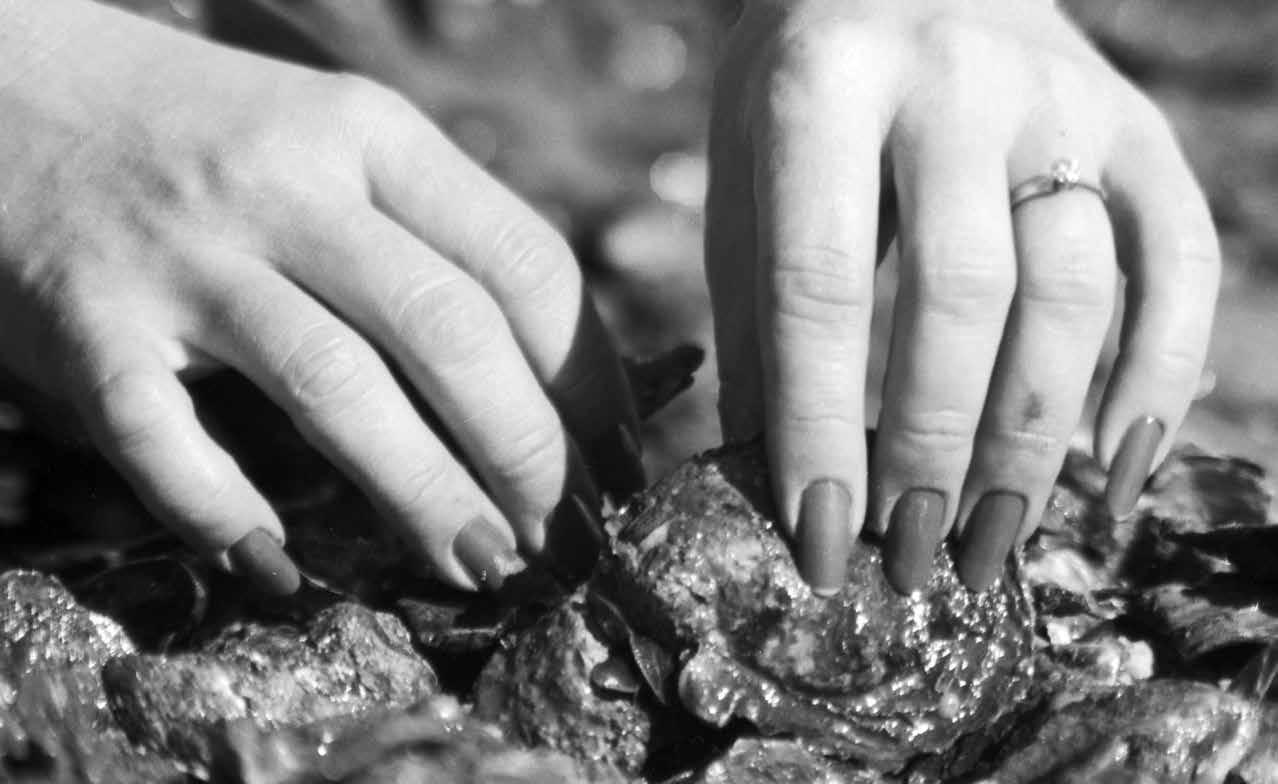
and assisting the work of men in the working maritime communities of the early 1980s. From Laura Era, who culled her husband’s oysters with her baby in the workboat’s cabin alongside her, to Patsy Higgs, who slung massive rockfish from poundnets like her father and brother, it was clear that women had long been tightly knitted into the organic working flow of life on the water. It was less of a statement about equality and more a practice borne of need and pragmatism. Women already acted as the middlemen, the net makers, the accountants for their men working the water. It was a natural leap for a daughter to take over the commercial fishing operation when her father became infirm or, in the case of Frances Grunden, to take over the family fish shop that sold the seafood her brothers and father caught.
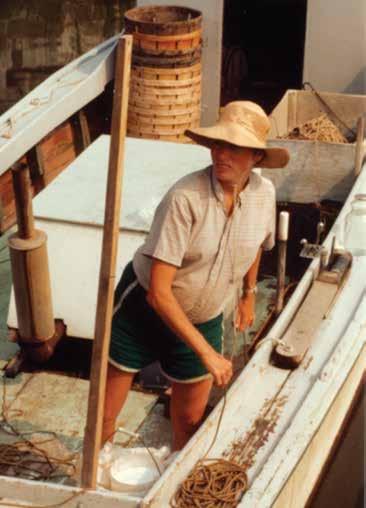

Line’s work was honest and groundbreaking. Although her photographs lacked the artistry of A. Aubrey Bodine, or the evocative loneliness of Robert de Gast, they sparkled with life and intimacy. Only a woman, the reader understood, would see the beauty in such commonplace moments—a manicured hand sorting through oysters, the curve of a pregnant belly over the lifted tension of
a running trotline. Line’s groundbreaking work would go on to win a $5,000 literary prize—and join a canon of documentary Chesapeake photography that still informs and intrigues.
Many of the women Line captured have died in the 35 years since the book was printed—along with Line herself— but Waterwomen still feels current. The contribution of women to the maritime world remains steadfast as ever, proving that this was never a man’s occupation. Rather, working on the water is a community’s job, where ultimately the demands of the fishery outweigh traditional gender roles. And if the water speaks to you, you follow it. As Patsy Higgs recounted over a poundnet full of wriggling fish, “I wouldn’t do anything now except fish. You forget about the days you get cold and have bad experiences—you forget all about those things. I guess this is just my way of life.”

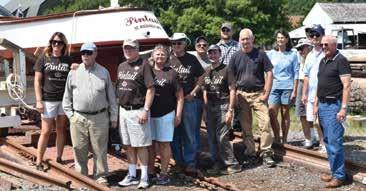
Major progress has been made in the historic restoration of the 1889 bugeye Edna E. Lockwood, with her existing topsides lifted by crane to sit directly above her new ninelog hull. Edna Lockwood represents the last of her kind, as the oldest historic log-hull bugeye still under sail.
In mid-September, the topsides were successfully transferred to sit just above the new hull, which shipwrights finished shaping earlier this year. At the same time, Edna’s original 1889 hull was moved to the other side of CBMM’s campus, where it will eventually be put on display.

The next phase in the restoration will see shipwrights marrying the two sections of the boat, while jacking the bottom up to meet the frames. New stems, hatches, and additional structures will also be installed, and new sails will be made.
The team is restoring CBMM’s queen of the fleet and National Historic Landmark Edna E. Lockwood by replacing her nine-log hull in adherence to the Secretary of the Interior’s Standards for Historic Vessel Preservation. Shipwright apprentices working on the project are generously supported by the Seip Family Foundation, and RPM Foundation. All work takes place in full public view through 2018, when Edna will be placed on the marine railway and launched at CBMM’s OysterFest in October.
To keep up with the project, including progress update videos, visit ednalockwood.org
Chesapeake Bay Maritime Museum staff and Apprentice For A Day Public Boatbuilding Program participants toasted the launch of Pintail, their 25-foot draketail, with cheers and champagne on Saturday, August 26. Construction of the boat, built through the AFAD Program, began in January 2016. Pintail has white cedar decks, forward and aft bulkheads, white oak engine bed logs, and a stainless rudder stuffing box. A Yanmar two-cylinder diesel engine was installed, and she is painted white with a red bottom.
Pintail features a reverse-rake round stern, referred to locally as a “torpedo stern,” “dovetail,” or “ducktail.” These were the first types of power workboats developed in the Chesapeake Bay region, having their heyday in the 1920s, while going out of style in the ’40s, when crab-potting became legal.
Pintail is now for sale. For more information about Boatyard programs or the purchase of Pintail, contact Jenn Kuhn at 410-745-4980 or jkuhn@cbmm.org. See more photos of the project at bit.ly/CBMMPintail
An Evening with Marc Castelli
Thursday, January 11
5–7pm, Van Lennep Auditorium Free for CBMM members
Registration required to 410-745-4991 or nwells@cbmm.org
Artist Marc Castelli returns to share a slide presentation featuring his annual show of photographs taken while out on the water in all the fisheries, for the year August to August. Attendance is limited.
Shipyard Archeology on Wicomico Creek
Tuesday, February 13
5–7pm, Van Lennep Auditorium Free for CBMM members
Registration required to 410-745-4991 or nwells@cbmm.org
This illustrated talk by Chief Curator Pete Lesher is an exploration of the history around an 18th century Somerset County site explored by archaeologist Jason Moser about 10 years ago under the auspices of CBMM. A context for shipbuilding in the period and specific findings from the investigation will be provided.
Metal Casting Thursday, March 15
5–7pm, CBMM Boatshop Free for CBMM members
Registration required to 410-745-4991 or nwells@cbmm.org
Join CBMM's shipwrights and visiting master Christian Benefiel for a metal casting demonstration and some interactive activity in the Boatshop.
Member Preview Opening: Kent County: Guides, Gunning Clubs, and Carving Co-ops
Friday, April 13
5–7pm, Small Boat Shed, Waterfowl Building Free for CBMM members
Registration required to 410-745-4991 or nwells@cbmm.org
Cradled by the Chester River and the Chesapeake Bay, Kent County’s rich environment has fostered a long tradition of waterfowl guiding, gunning clubs, and decoy carving. Carvers like John Glenn, the Uries, and Charlie Joiner created unique rigs that were commissioned and gunned over on secluded Kent County coves teeming with waterfowl.
Apprentice For A Day Boatbuilding Program
Most Saturdays and Sundays beginning January 6 10am–4pm, CBMM Boatshop $45 CBMM members; $55 non-members Journeyman Special (four individual classes): $150 CBMM members; $200 non-members Registration encouraged to 410-745-4980 or afad@cbmm.org
Learn traditional boatbuilding skills under the direction of CBMM shipwrights while helping them build a boat. Join Boatyard Programs Manager Jenn Kuhn in building a 12’ Iain Oughtred acorn skiff. Be part of the whole process, or just sign up for those aspects of building a boat that interest you most.
Two-Day Boating Essentials
Saturday, January 6, 10am–noon Sunday, January 7, 2–4pm Van Lennep Auditorium $25 for CBMM members; $35 for non-members Registration required to bit.ly/BoatingEssentials_Jan2018
Led by Captain Jerry Friedman, a 100-ton, USCG-licensed Master, class participants will gain knowledge and confidence in reading charts, understanding navigational aids, plotting courses, proper anchoring, knot tying, knowing what to do in emergencies, and other helpful information for anyone who spends time aboard a boat.
Two-Day Chart Navigation Saturday, January 13, 10am–noon Sunday, January 14, 2–4pm Van Lennep Auditorium $25 CBMM members; $35 non-members Registration required to bit.ly/ChartNavigation_Jan2018
In this two-day workshop, Captain Jerry Friedman, a 100-ton, USCG-licensed Master, will teach participants the necessary steps needed to plan a cruise using navigation charts, including plotting courses to safely pilot a boat from one location to another. Boaters interested in being more proficient in navigation will learn the techniques to determine a boat’s location without the use of electronic aids.
Three-Day Bronze Casting Workshop
Thursday, March 15 to Saturday, March 17 9am–4pm, CBMM Boatyard $425 CBMM members; $475 non-members Registration required to bit.ly/BronzeCasting_March2018
Join nationally renowned sculpture artist and Shepherd University professor Christian Benefiel as he guides you through the intricacies of casting bronze and aluminum, including creating molds, working the sand and furnace, and pouring molten metal. Participants will take home a working knowledge of casting metal and their own creation. Materials included in the registration fee.
Recommissioning Your Outboard & Inboard Motor Wednesday, April 25, 5:30–8:30pm (outboard motors) Saturday, April 28, 9am–noon (inboard motors)
CBMM Boatshop
Cost per workshop: $30 CBMM members; $45 non-members Registration required to bit.ly/OutboardMotors_April2018 or bit.ly/InboardMotor_April2018
Josh Richardson, CBMM’s marine mechanic, will lead two workshops on recommissioning your engine. Richardson will lead participants through checking the engine’s running condition and temperature, ignition, and starting systems, and will demonstrate how to replace the engine’s fuel filter.
WINTER 2018 SPEAKER SERIES:
Picked, Packed, and Shipped:
Tomato Canning in the Chesapeake Long before refrigeration made crabs the juggernaut of the summer canning season, the tomato was the warm-weather king of Chesapeake packing houses—and the counterpart to the mighty wintertime oyster harvest. In our four-part series, explore the fascinating ways that canning transformed the Chesapeake’s industry, culture, community, and agricultural landscape of the 19th and 20th centuries, through lectures, objects, films, and community conversations.
Cost per one-hour session: $6 for members; $8 for non-members Register for all sessions and save: $20 for members; $28 for non-members.
All sessions held in CBMM’s Van Lennep Auditorium. For details visit cbmm.org.
Thursday, February 8, 2pm:
Join CBMM Chief Curator Pete Lesher and Collections Manager Jen Dolde as they discuss the Eastern Shore’s produce packing past with a panel of community members. Selected images and objects from CBMM’s extensive collections will be used to generate conversation; audience participation is encouraged.
Thursday, February 15, 2pm:
Screening of the Tilghman Watermen’s Museum’s film Til-Made: Remembering the Tilghman Packing Company, a history of the Tilghman Packing Co., as told by island residents and those who worked there. A facilitated community conversation by Tilghman residents who remember the packing company’s heyday will follow.
Thursday, February 22, 10am:
Join Ed Kee, former Delaware Secretary of Agriculture and author of Saving Our Harvest: The Story of the Mid-Atlantic Region’s Canning and Freezing Industry, for a discussion of the Chesapeake’s once-mighty canning industry and the ways it impacted life in Chesapeake communities, both large and small, over its 100-year peak.
Thursday, March 1, 10 am:
Join University of Maryland, Baltimore County Chief Curator Emeritus Tom Beck as he discusses the remarkable photography of children’s labor law reformer Lewis Hine. As a photographer for the National Child Labor Committee, Hine documented and exposed the unethical working conditions experienced by children in early 20th-century Maryland canneries. Beck will explore UMBC’s collections of Hine’s groundbreaking photography, and the importance and legacy of his work for social justice.
Docent Training
Tuesdays and Thursdays
March 6, 8, 13, 15, 20, 22, 27, 29 10am–12:30pm, Van Lennep Auditorium
Join us for a volunteer docent training program to provide the basic information for becoming a museum interpreter. This training program, led by CBMM’s Education team, covers topics ranging from CBMM’s exhibitions and collections, to tour group management techniques.
Registration is required by contacting CBMM Volunteer & Education Programs Manager Allison Speight at aspeight@ cbmm.org or 410-745-4941.
Two-Day Rising Tide Holiday Gift Making Workshops Mondays & Wednesdays
December 4 & 6, 11 & 13, 18 & 20 3:30–5:30pm, CBMM Boatshop Free, but class size is limited Registration required to risingtide@cbmm.org or cbmm.org/risingtide
Create holiday gifts for friends or family! Two-day workshops will be held between Thanksgiving and Winter Break. Projects vary from beginner to intermediate skill levels. View the current Rising Tide class schedule, and sign up at cbmm.org/risingtide.
Family Boatshop
Saturdays: December 9, January 20, February 17, March 10, May 12 10am–4pm, CBMM Boatshop Cost includes one youth (age 10 and up) and one adult: $45 CBMM members; $55 non-members Registration required to 410-745-4980 or jkuhn@cbmm.org
Join CBMM shipwrights in the Boatshop for a family experience. Projects vary each month, from steam-bent bird feeders, to spar making, to helping build a 12’ acorn skiff. For ages 10 and up; children must be accompanied by an adult.
Family Photography Workshop
Saturday, January 20
1–2:30pm, Van Lennep Auditorium $5 CBMM members; $8 non-members Accompanying younger siblings ages 5 and under free
Registration required to bit.ly/FamilyPhotography_Jan2018
Explore the work of Robert de Gast and learn some of the photographic principles that make his images so captivating. Then, take your own de Gast-inspired pictures using your smartphone or camera on CBMM’s campus. This workshop is perfect for families of all sizes.
This February, bring your little mariner to CBMM to join our STEAM Team! Each week, STEAM Team participants will join instructor Martha Hamlyn in a hands-on exploration incorporating STEM (Science, Technology, Engineering, Math) with the arts.
Two sessions daily: 10am–noon for 4–6-year-olds; 1–3pm for 7–9-year-olds.
February 3: Digging in the Past: Historical Treasures under our Feet
February 10: Lab Kids: Fizz, Bubble, Pop
February 17: Digging into the Past: Happy Birthday, Frederick Douglass!
February 24: Lab Kids: Toy-making
Cost: $12 per class for CBMM members and $15 per class for non-members. A special four-session pass is available at $40 for CBMM members and $50 for non-members. Scholarships for individual classes are available for qualifying students. Registration is required to cbmm.org/learn/steam-team.
Homeschool Day
Tuesday, April 3 10:30am or 1pm $5 per person. Accompanying younger siblings ages 5 and under free
Registration required to bit.ly/HomeschoolDay_April2018 Homeschool students and their adults are invited to come to CBMM’s spring Homeschool Day, selecting either a morning or afternoon program to explore how changing technology has impacted people in the Chesapeake for generations. Students will use tools, touch baskets, and hands-on demonstrations to consider the scientific principles behind some great innovations in Chesapeake boatbuilding, navigation, and engineering. Families are encouraged to bring a bag lunch to picnic on campus. The Campus Challenge scavenger hunt will be available for families to explore other CBMM highlights at their own pace. Individual families and co-op groups alike are welcome to attend.
Your group can spend the night in our 1879 Hooper Strait Lighthouse! Travel back in time to experience the rustic life of a lighthouse keeper with hands-on, interactive activities, games, and stories. Designed for youth groups, children's organizations, and scouts ages 8 to 12 (and their chaperones), the program is available Fridays and Saturdays in the spring and fall, beginning at 7pm and ending at 9am the following day.
Friday and Saturday: April 6–April 7 April 13–April 14 April 20–April 21 April 27–April 28
May 4–May 5 May 11–May 12 May 18–May 19 May 25–May 26
June 1–June 2
June 8–June 9 June 15–June 16 June 22–June 23
Cost: $40 for per person with a 12-person minimum, 18-person maximum. Fee includes one overnight stay in the Lighthouse, a dedicated facilitator, the cost of program activities, two days’ admission to CBMM, a souvenir patch, and (seasonally available) a complimentary boat ride on the 1920 buyboat Winnie Estelle. Space is limited, and reservations are on a first-come, first-served basis. Boat rides are weather permitting. For inquiries about the program or to make a reservation, visit cbmm.org/learn/lighthouse-overnights.
Family Day at CBMM Saturday, April 21 10am–2pm
All activities included with general CBMM admission; educators may register at bit.ly/FamilyDay_April2018 for free family admission
Get hands-on with our campus! Your family will have a chance to explore CBMM through hands-on activities and familyfriendly exhibits, perfect for a day of family fun.
Rising Tide After-School Boatbuilding Classes
Tuesdays and Thursdays
3:30–5:30pm, CBMM Boatshop Free, but class size is limited For students in grades 6–10 Transportation is available from Easton Registration required to risingtide@cbmm.org or cbmm.org/risingtide
Build a boat from log to launch! This year, Rising Tide students are building two 16-foot Smith Island outboard skiffs, which will be launched at CBMM’s Community Day on May 20, 2018. Sign up for a single class, or for every class. No experience necessary. View the current Rising Tide class schedule, and sign up at cbmm.org/risingtide
Rising Tide After-School Workshops and Events
Mondays, Wednesdays, Fridays 3:30–5:30pm, various locations Free, but class size is limited For students in grades 6–10 Free transportation is available from Easton Registration required to risingtide@cbmm.org or cbmm.org/risingtide.
Rising Tide offers workshops in boating safety, milling machines, girls’ woodworking, bicycle repair, outboard motors, canvas stretching and painting, and more. View the current Rising Tide class schedule, and sign up at cbmm.org/risingtide


Wednesday, December 6
4–7pm, Museum Store
Free
Join us to celebrate the holiday season with caroling, special deals in the Museum Store, children's activities, light refreshments, and more.
Volunteer Friendraiser
Monday, February 12
3–5pm, Van Lennep Auditorium Free; Registration encouraged to bit.ly/CBMMFriendraiser
Are you a friendly, outgoing lover of the Chesapeake?
Do you enjoy working with people? If so, the Chesapeake Bay Maritime Museum needs you!
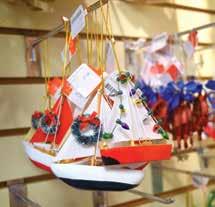
We want to grow our public programs—and we are looking for new volunteers interested in learning how to lead tours exploring the Bay’s history, culture, and environment. No experience is necessary, but an enthusiasm for the Chesapeake, a willingness to learn, and the gift of the gab are essential.
To hear more about our interpretive programs, join us at our Volunteer Friendraiser. There will be plenty of information on CBMM tours and training, as well as a great chance to mix and mingle with current volunteers, docents, and staff.
To see more of what’s happening at CBMM, flip through the albums on our Flickr page at flickr.com/cbmmphotos, and follow us on Facebook, Twitter and Instagram!
Rising Tide After-School Boatbuilding Program participants launched Cattail, the railbird skiff they built at this year’s Community Day in May. The free program is open to students in grades 6–10, and offers weekly boatbuilding classes, workshops and events. Sign up for offerings and for the Rising Tide newsletter to stay informed of upcoming programs at cbmm.org/risingtide.

In April, the new hull for 1889 bugeye Edna E. Lockwood was flipped by crane so that CBMM’s shipwrights and apprentices could finish its construction. It’s since been finished and placed directly under her existing topsides so staff can marry the two pieces of the historic vessel.
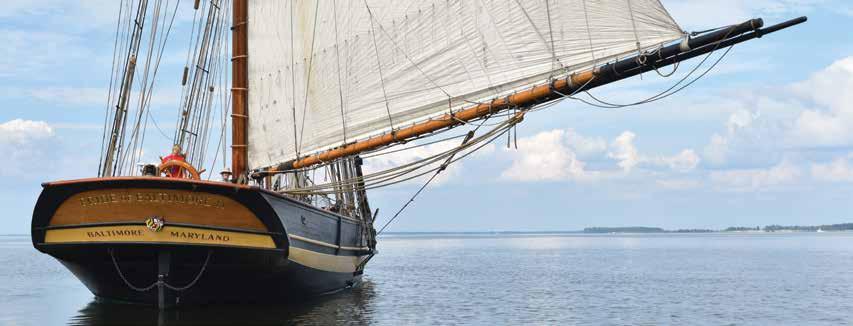
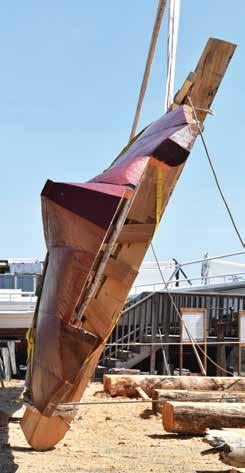
Edna Lockwood will be re-launched at next year’s OysterFest, October 27, 2018.
Master blacksmiths from Mystic Seaport in Connecticut visited CBMM in March, providing both private lessons to CBMM Boatyard staff, plus a public workshop. A number of boatyard programs are planned for this winter and spring, covering a range of topics from bronze casting to engine maintenance. To find one that suits you, or to learn about our Apprentice for a Day Boatbuilding Program, visit cbmm.org.
CBMM saw a number of tall ships at its docks this summer, including replica schooner Pride of Baltimore II (pictured) in August. Also visiting were Stanley Norman, Sultana, Sigsbee, Lady Maryland, and Maryland Dove, a replica of the late 17th century trading ship that brought the first settlers to what is now Maryland.
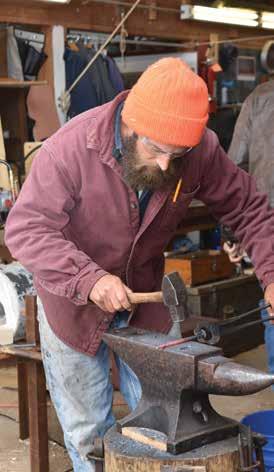
Your Annual Fund gift supports everything from our hands-on education and boatbuilding programs and seasonal festivals that celebrate the way of life on the Bay, to restoration projects, interactive exhibitions, and more than 70,000 irreplaceable objects in our collection. In addition, your donations to The Annual Fund help keep our exhibitions, historic buildings, and waterfront grounds in beautiful and welcoming condition.
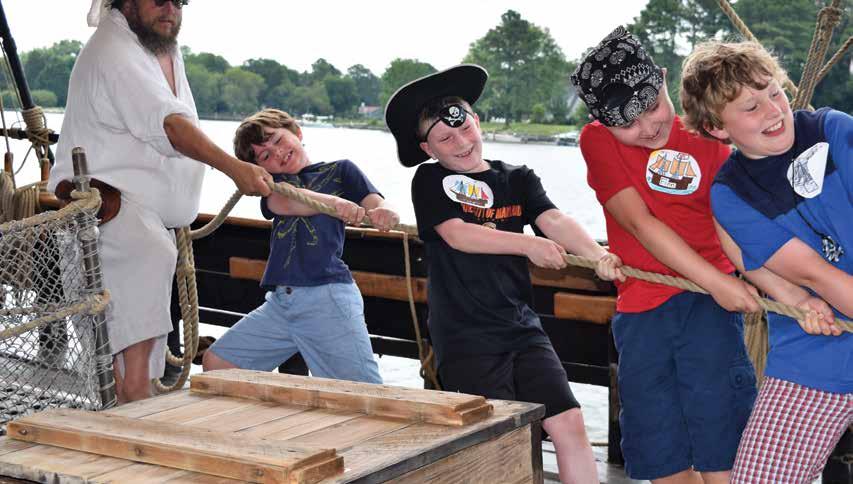
To learn more about us, or to make a gift online or over the telephone, please visit cbmm.org/support/donate or call
